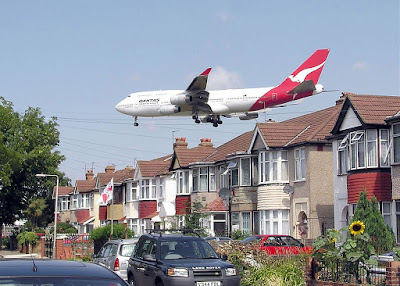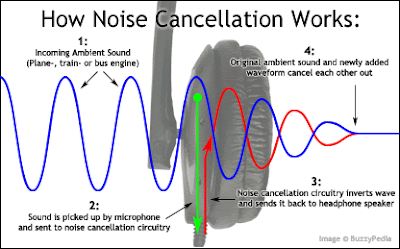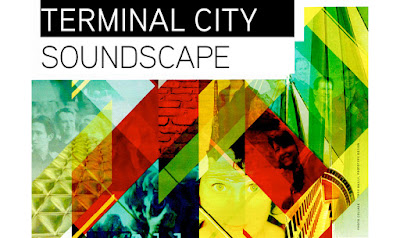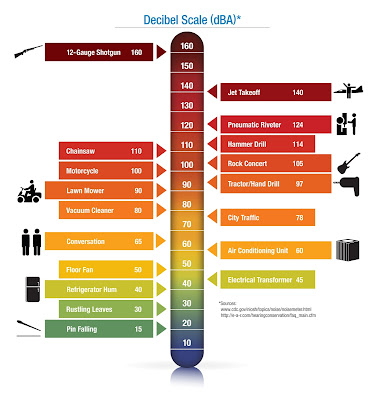A Quieter City Through Design and Architecture
Ever thought that the sounds surrounding you are an "ear-sore"? The New York Times architecture critic Kimmelman agrees with you. He recently published a neat little piece titled "Dear Architects: Sound Matters". A great reminder! In it he postulates:
"During the Middle Ages, smell was the unspoken plague of cities, today it is sound." writes New York Times architecture critic Michael Kimmelman. "
Embedded in the online version of his article are intimate sound tracks of New York spaces, tracking the critic's experience of sound in various enclosed environments such as the Grand Central and Penn train stations, the office and a public library. Kimmelman describes sound as an essential component of experiencing space. As such sound adds another dimension to form and light (both visual), a dimension of architectural design which is usually overlooked.
 |
| Airplanes rarely fly so low above cities, but in some places like San Diego they still do |
Indeed, architecture isn't just for the eyes. Not only does sound remain a stepchild in architecture, one can suspect that it has become more so over time. The understanding of sound diminished with the advance of technology. Just as air conditioning has obscured the art of natural cooling through architectural design, microphones and speakers have made finely sound tuned spaces are rarity. Even in the smallest settings speakers now carry microphones. Did you ever wonder how Lincoln delivered the Gettysburg address without a sound system? Old cathedrals and churches are evidence how the human voice can reach many hundreds of listeners without electricity if a space is designed with sound in mind.
Kimmelman alludes that sound could be integrated as a sense-enriching component of design today as well, and that is certainly true. When I finished reading the article and listening to the sound examples, though, I felt that Kimmelman's own pronouncement of sound as the new unspoken plague of cities was lost in the more esoteric, romantic exploration of the sensuality of sound.
"Sound matters" is not only true in the sense that consideration of sound could make spaces a lot better, it is also true that neglecting sound can make spaces a lot worse, even unhealthy. Sound affects our health and well being in very direct ways almost everywhere we go. Sound can soothe people or even transform them to a hypnotic state, but all too often it assails man and animal through poor design, or worse, intent. That is when sound morphs becomes noise, and how it becomes "the plague of cities".
| Not always is discomfort so blatantly obvious |
One of the physical consequences of incessant noise bombarding us is damage to the ears. One form of damage is tinnitus, a condition millions of Americans suffer:
Tinnitus is the perception of sound when no actual external noise is present. While it is commonly referred to as "ringing in the ears," tinnitus can manifest many different perceptions of sound, including buzzing, hissing, whistling, swooshing, and clicking. In some rare cases, tinnitus patients report hearing music. Tinnitus can be both an acute (temporary) condition or a chronic (ongoing) health malady.
Millions of Americans experience tinnitus, often to a debilitating degree, making it one of the most common health conditions in the country. The U.S. Centers for Disease Control estimates that nearly 15% of the general public — over 50 million Americans — experience some form of tinnitus. Roughly 20 million people struggle with burdensome chronic tinnitus, while 2 million have extreme and debilitating cases. (American Tinnitus Association)
 |
| Sound management |
New York the Noisiest City on Earth
WHEN a sudden scratching of pens over the Declaration of Independence disturbed the peace of the Colonies a hundred and twenty-nine years ago, the United States began being the noisiest nation on earth. New York then was quiet and New Yorkers peace-abiding as compared with what is promised for next Tuesday -- the noisiest day of the noisiest year of the noisiest city in the world.
This label may be no longer accurate (if it ever was, how about Calcutta or Mumbai which seem to lead more current lists?), but based on anecdotal evidence the US is an on average rather loud country with little appreciation for silence or quiet. The strict rules that apply in many European cities regulating noise on all levels down to the prohibition of loud machinery on Sundays, at night, or in some regions even during siesta (nap time), are seen as quaint here, unattainable and certainly know no equivalent.
Quite to the contrary, people seem to like it loud: Music and announcements blaring from hidden speakers in supermarkets, headphones piping another world into the ears during jogging in the otherwise quiet woods, and restaurant music often forcing customers to shout to be heard are just as common as the horns of firetrucks which seem to be designed to move obstacles with sheer sound pressure. Some of the top noise makers can certainly blow an infant's eardrums in an instant. Juvenile car owners who buy the extra loud exhausts, aging motorcycle cowboys who let their bikes roar, trash trucks which leave the assembly line without any sound encapsulation, all that is so much a part of daily life that most people don't seem to think about it. Until they get sick, that is. Or until they travel and experience how quiet a restaurant in France can be or a car free piazza in Italy, or how their loud conversation dominates sound in an Italian church.
Noise as a subset of sound is accurately described in the field of physics known as acoustics: waves, resonance, cancellation, reverberation and sympathetic vibration. One of the things beyond the grasp of many is the logarithmic scale of the measurement of sound, the decibel. Logarithmic means that an increase of 10dB means doubling the intensity of sound, i.e. 55dB is twice as loud as 45dB.
When the EPA still had noise in their portfolio in the 1970s, they had a noise control program in which they established that average outdoor residential sound levels should be below 55 decibels (the lower end of the sound range produced by dishwashers or air conditioners). For indoors, the acceptable average levels were defined as less than 45 dB, which would appear from noise tables to be somewhere in between a"quiet library" and rainfall. It only takes 30dB, however, to disturb sleep.
Cardiovascular effects begin to be seen after exposure to sounds at 65dB. Noise levels above 80 dB are associated with both an increase in aggressive behavior and a decrease in behavior helpful to others according to health studies. Depending on the duration of exposure, hearing impairment can begin at around 85dB, roughly equivalent to the noise of heavy truck traffic on a busy road and still a good bit below the roar of starting jetliner. Maximum noise levels on NYC subway platforms have been measured at 108 dB, that's about what you hear from a chainsaw at a distance of one meter. Fire truck air horns can exceed 125 db. (list of sounds).
Sound cannot only be avoided through careful design, it can also be manipulated and orchestrated, it can enhance experience as we discussed in the beginning. One of the more sophisticated methods of manipulation is sound cancellation where one sound kills the other, not unlike firefighters who set fire to extinguish wildfires.
The same understanding of the properties of sound and how resonance, reverberation and attenuation work that allows designers to make sound an impressive positive experience is also required to mitigate sound that is a health impact. But US architects rarely use sound consultants (acousticians) for anything but the design of concert halls. By contrast, Europeans add acoustics consultants for ordinary tasks such as designing schools and classrooms.
Hearing the instructors and fellow students while not being disturbed by outside noise or the sound waves coming from neighboring classrooms is certainly a basic precondition for successful learning.
Getting a good night of sleep without having to listen to neighbors having an argument or noisy sex, without waking from trash trucks collecting garbage, noisy air conditioners or heater fans starting up, or being bothered by rushing sounds of badly insulated water lines, should be a basic right that comes with renting or buying an apartment. In most cases, that is not so.
A good night of sleep would be even more important for a hospital patient in recovery. Yet patients are disturbed as a matter of routine and sound is introduced even into spaces reserved to those who get ready to die. A patient's world is a cacophony of sounds and beeps emanating from the plethora of machines engaged in monitoring. Only recently has it been recognized that the hospital noise slows the healing of patients and stresses the nerves of care givers.
Humming ballasts of fluorescent lights, noisy air ducts, loud PC fans and the sound of phones and beeping copy machines can make the work environment a place of torture instead of creativity even if co-workers are considerate and refrain from listening to music via squawking headphones or having loud conversations. These issues become an even greater issue in the age of the open office landscape. Information about the acoustical properties of items that need to be specified is hard to come by, though.
Eating at popular sidewalk cafes can become a terrible experience in a noisy street with truck fumes blanketing the food. Sitting on an urban plaza to catch a breath or watch people can be spoiled by a guy showing up with one of those ear splitting noisy blowers that have replaced the comforting broom sounds of traditional street-sweepers. A repair executed from one of those hydraulic lifts that beep with every movement they make can drive anybody nuts for blocks around. Pedestrians, crammed on often too narrow sidewalks, are subjected to incessant car horns, sirens, the startling honks of cars being locked or unlocked via remote, news and police helicopters hovering overhead, planes dragging advertising banners and a plethora of other noise that we associate with the city. Together they form the urban hum one can hear for miles.
In spite of the all encompassing impact of sound, there is hardly an area that is more neglected, has sloppier execution and less enforcement than sound management. Little change is in sight.
Inside buildings the methods of sound mitigation in need of oversight range from simple sound separation (apartments are supposed to be separated by 50dB walls) to the management of impact noise (heels clicking on hard floor surfaces). While a stud wall with the two layers of drywall required for fire separation may actually provide 50dB sound reduction on paper, it will almost certainly not do that where the wall is connected to the facade, to other walls, or where it is weakened by receptacles and the like. Sound can travel through small spaces which can actually act like amplifiers.
The simplest way of keeping airborne sound in check inside a building is heavy material (a blockwall separation between units, for example). But the bigger the arsenal of sound, the flimsier the typical production dwelling unit or house gets in the name of cheaper and faster production. I have written about the trend towards wood framing even for large five story urban apartment buildings, including plywood floors nailed to wooden trusses and beams. Those construction methods do not attenuate sound through weight but through an intelligent layering of materials that one by one filter the various kinds of sound waves out. While the layering approach works well in theory, it immediately fails when sound sources are not properly isolated or when installations in the hollow walls compromise their performance.
Noise management in the city should be an integral part of design on all levels. Of course, local regulation is powerless if federal rules don't control truck noise, for example. The technology to encapsulate truck engines is known and applied in Europe but in the US the urban fleet of fire, dump and trash trucks can often be heard long before they can be seen. That is especially irksome since those vehicles often operate at night.
 |
| Soundscape, capturing Vancouver's sounds in an artistic program |
Klaus Philipsen, FAIA
edited by Ben Groff, JD
Links:
Shea Trahan, TED talk
Why City Noise is a serious Health Hazard (CityLab)
Decibel Hell: The Effects of Living in a Noisy World (NIH)
Acoustic Comfort
How loud is it? (New York Magazine)
The Sound of Silence (The Economist)

